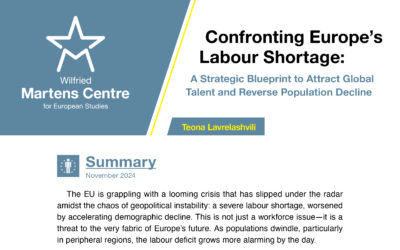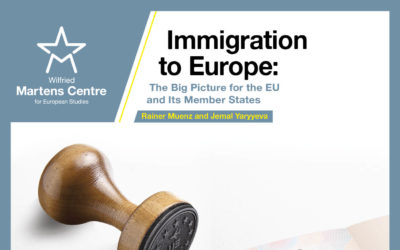 Loading...
Loading...-
Last week, the European Commission unveiled its “Competitiveness Compass”, a long-term roadmap designed to strengthen Europe’s economic resilience. It rightly identifies innovation, energy affordability, and reducing strategic dependencies as core priorities for the EU’s future. The strategy makes a compelling case for cutting red tape, boosting industrial innovation, and aligning green policies with economic growth.
But one fundamental challenge is conspicuously underdeveloped: Europe’s growing labour shortages and demographic crisis.
The EU’s global competitiveness is not just about technological leadership or regulatory efficiency – it is about people. Without a sufficient workforce, no level of innovation, investment, or regulatory streamlining will be enough to sustain long-term prosperity. Yet, the Competitiveness Compass fails to address the need for a coherent, urgent response to the continent’s labour shortages. If the EU does not act now, its workforce crisis will become the single biggest obstacle to achieving the economic vision set out in this new strategy.
The Workforce Crisis is an Economic Crisis
Europe’s labour shortages are no longer sector-specific problems—they are becoming a systemic constraint on growth. The OECD Talent Attractiveness Index consistently shows that the EU underperforms in attracting high-skilled talent compared to the U.S., Canada, and Australia. Meanwhile, Eurostat projects that the EU’s working-age population will shrink from 65% today to just 54%-56% by 2070.
These demographic trends are not just statistics – they are existential threats to European competitiveness. A shrinking workforce means fewer innovators, fewer skilled professionals in key industries, and increasing pressure on social systems. Already, major sectors such as healthcare, engineering, and digital industries are struggling to fill positions, while rural regions face severe depopulation and economic stagnation.
Despite recognising the need for a skilled workforce, the Competitiveness Compass does not treat labour shortages as an immediate crisis. This is a major oversight. Without serious interventions, the EU’s economic model will become unsustainable – not because of lack of investment or industrial policies, but because there simply will not be enough workers to power its growth.
If the Competitiveness Compass is to truly safeguard the EU’s long-term economic future, it must elevate labour shortages and demographic decline as core pillars of its strategy. As outlined in this Martens Centre policy brief, addressing these challenges requires three bold policy shifts:
1. A Talent-Centred Migration Strategy
Europe’s migration policies are not designed for global competition. While Canada and the U.S. actively recruit high-skilled talent, the EU remains bureaucratic, slow, and fragmented.
To address shortages, the EU should:
- Create a streamlined EU-wide Talent Visa, similar to Canada’s Global Talent Stream, reducing work permit bureaucracy for high-demand sectors.
- Expand Talent Partnerships with key non-EU countries to attract skilled workers in tech, healthcare, and engineering.
- Harmonise recognition of foreign qualifications to allow non-EU professionals to fill gaps faster.
The Competitiveness Compass mentions talent attraction, but without serious structural reforms, Europe will continue losing skilled workers to other, more attractive global destinations.
2. An Aggressive Upskilling & Reskilling Strategy
The Competitiveness Compass calls for more investment in innovation, but it does not adequately address the workforce skills gap.
A truly competitive Europe needs:
- A European Digital and Green Jobs Academy, providing fast-tracked training for workers transitioning into high-demand sectors.
- Stronger public-private training partnerships, ensuring businesses are actively investing in workforce development.
- A pan-European mobility programme for upskilling and reskilling workers across borders.
Without a bold upskilling push, the EU risks investing in high-tech industries that lack the skilled workers needed to sustain them.
3. A European Demographic Strategy – Not Just a Workforce Fix, But an Economic Necessity
For years, European policymakers have avoided serious conversations about demographics. This must change. If the EU wants sustainable competitiveness, it must recognise that a shrinking workforce is an economic crisis.
The EU should:
- Create a European Demography Fund, supporting policies that encourage family formation and regional revitalisation.
- Introduce tax incentives for working parents and support family-friendly workplaces.
- Align demographic policies with economic goals, ensuring that Europe remains both a top destination for skilled workers and a place where families thrive.
If Europe fails to address its long-term demographic decline, no amount of investment in competitiveness will compensate for a workforce that simply isn’t there.
The EU Needs a Workforce Compass
The Competitiveness Compass is a step in the right direction, but without a clear strategy for addressing labour shortages and demographic decline, it lacks a solid foundation. A strong, resilient, and innovative Europe cannot thrive without a workforce to sustain it.
If the EU truly intends to remain a global economic leader, it must prioritise talent, skills, and demographic renewal as core pillars of its competitiveness agenda – not afterthoughts. The clock is ticking. The question is no longer whether Europe can afford to act, but whether it can afford not to.
Teona Lavrelashvili Economy Labour

Teona Lavrelashvili
Europe’s Competitiveness Compass is Pointing in the Right Direction – But it Overlooks the Workforce Crisis
Blog
04 Feb 2025
-
The EU is grappling with a looming crisis that has slipped under the radar amidst the chaos of geopolitical instability: a severe labour shortage, worsened by accelerating demographic decline. This is not just a workforce issue—it is a threat to the very fabric of Europe’s future. As populations dwindle, particularly in peripheral regions, the labour deficit grows more alarming by the day.
Drawing on best practices and informed by the current political and socio- economic landscape, this policy brief argues that attracting young global talent, particularly through education, is no longer a choice but a necessity to combat depopulation and ignite economic revival. This policy brief sets forth urgent recommendations which include establishing clear migration targets, strengthening reskilling and civic–linguistic training programmes for migrants, fully digitising migration-management processes and fostering cooperation with source countries. Together, these measures should aim to build a compelling ‘European Dream’, attracting and retaining the skilled individuals essential for the continent’s future prosperity.
Demography Labour Migration
Confronting Europe’s Labour Shortage: A Strategic Blueprint to Attract Global Talent and Reverse Population Decline
Policy Briefs
12 Nov 2024
-
Who are the migrants living in the EU? Who has arrived here over the past 10 years? And to what extent have these migrants integrated? This paper provides answers based on the data on foreign-born residents, first residence permit data, statistics on first asylum requests and information on temporary protection for Ukrainians. It includes a number of novel data breakdowns.
The main finding is that over the past 10 years, about 50% of all people immigrating to the EU have been admitted for humanitarian reasons. Some 27% arrived as marriage migrants or for family reunion purposes. The number of those admitted for employment was just 17%. Notably, a third of all immigrants coming to the EU during the past 10 years arrived in 2022.
The paper shows that labour market outcomes depend to some extent on the structure of migration flows. Mobile EU citizens usually move for reasons of employment. Third-country nationals residing in the EU have much lower employment rates and a significantly higher risk of working below their skill level. Those third-country nationals admitted as refugees, for family reunion reasons or as marriage migrants are less likely to integrate into EU labour markets. This is particularly true for female migrants.
Throughout the EU, native workforces are shrinking. Migrants can only compensate for the emerging gaps if their talents and skills are compatible with Europe’s needs. This necessitates the admission of non-EU migrants based on their skills acquired abroad and a rapid recognition of these skills, or the massive retraining of migrants who do not meet the necessary criteria. In any case, European societies will have to put more emphasis on the integration of migrants and their EU-born children.
EU Member States Immigration Integration Labour Migration Refugees
Immigration to Europe: The Big Picture for the EU and Its Member States
Research Papers
30 Jul 2024


